Seminar "The Inca Presence in Argentina"
Organized by: Institute of Archaeology, Faculty of Philosophy and Letters, UBA – Fundación Proa
Coordinator: Axel Nielsen
Faculty: Verónica Williams – Norma Ratto – Constanza Taboada – José Vaquer – Marco Giovannetti – Pablo Cruz – Axel Nielsen
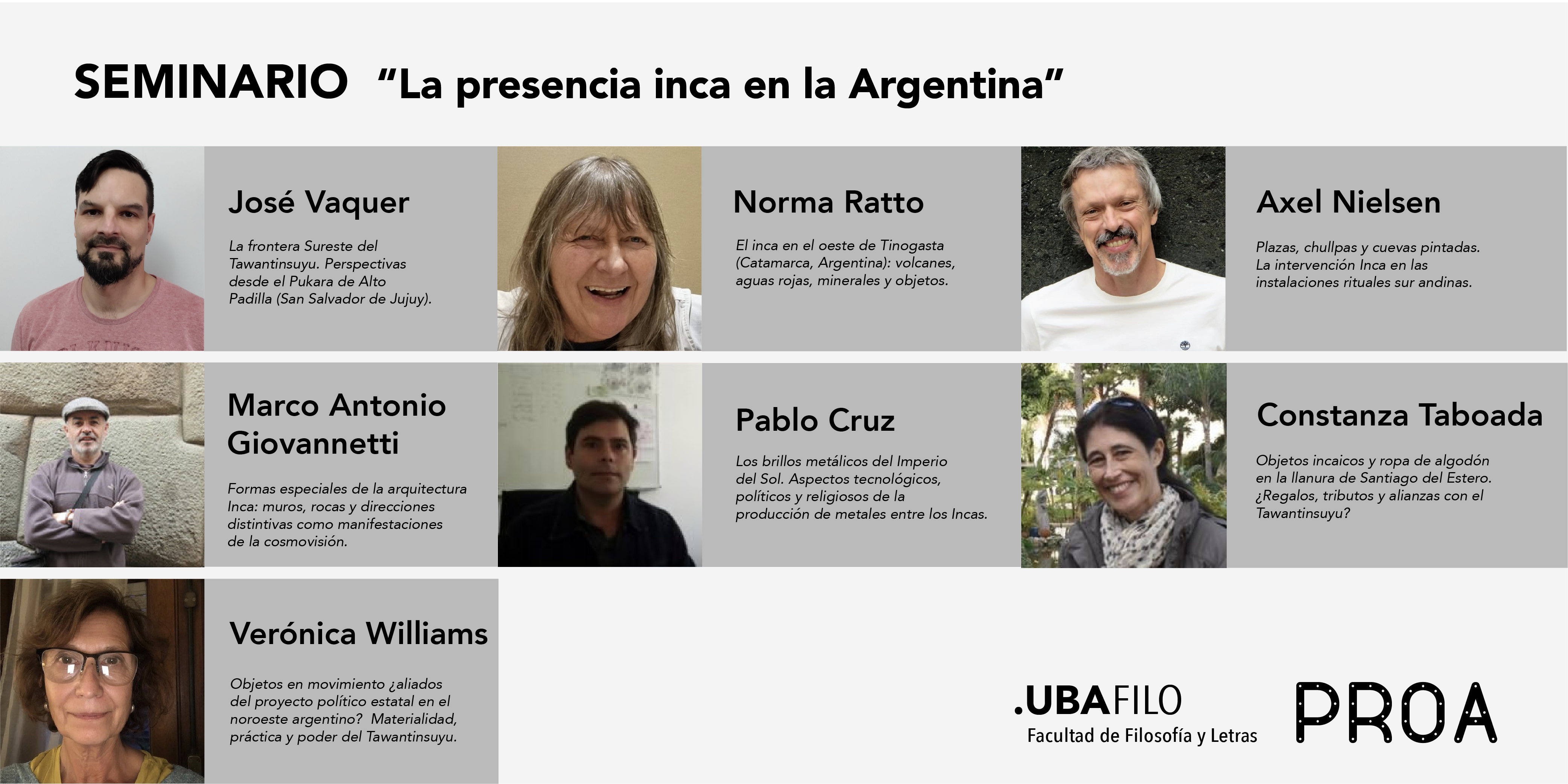
Presentation
This seminar aims to reflect on the nature of the Inca presence in present-day Argentine territory, focusing on the active role that objects play in social life. This approach involves considering how materials shape human practices and subjectivity through their physical properties, as well as the meanings these properties and objects acquire within the framework of the Andean worldview, including their animated nature. How did the iconography and designs embodied in various materials contribute to creating a sense of community among the diverse groups incorporated into the Tahuantinsuyu? How did objects work to legitimize the Inca's right to govern the largest and most culturally heterogeneous state in pre-Hispanic America? Can we think of pottery, textiles, metals, architecture, or roads as “allies” in the Inca political project? In what ways? How does a materiality-centered perspective enhance our understanding of the Tahuantinsuyu?
This seminar, organized by Proa, will bring together prominent Argentine professionals in Inca archaeology. Through discussions of recent studies on various materials (ceramics, metals, textiles, architecture, rock art) and their contexts, they will share their insights on these topics. The presentations will provide a broad conceptual framework, offering greater depth and complexity to the interpretation of the pieces exhibited in “The Incas: Beyond an Empire” and delivering a perspective rooted in the southern territories of the Tahuantinsuyu. Additionally, the seminar as a whole will outline an updated panorama, not only of current research in Argentine Inca archaeology but also of contemporary debates on the materiality of social processes.
The seminar is structured around presentations lasting between 20 and 25 minutes, followed by an equal amount of time for questions and discussion. It is intended for a broad audience, including students of anthropology, archaeology, and history, as well as young professionals. It also welcomes enthusiasts of these disciplines who frequent museums and other cultural spaces in the city.
Classes
Jose Vaquer: The Southeastern Frontier of Tawantinsuyu: Perspectives from the Pukara of Alto Padilla (San Salvador de Jujuy)
The presentation discusses the Inca presence at the Pukara of Alto Padilla, San Salvador de Jujuy, and its role in articulating the frontier with the Lowlands. Based on the spatial articulation and recovered materials, Vaquer is proposing that relationships with the Lowland populations were more dynamic and changeable than colonial written sources suggest.
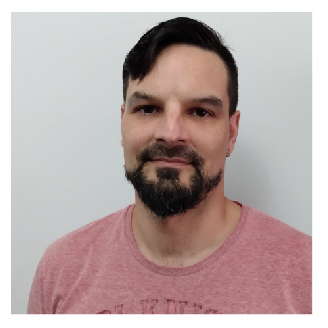 José María Vaquer (CONICET, UBA)
José María Vaquer (CONICET, UBA)
Vaquer holds a PhD in Archaeology from the University of Buenos Aires. He is currently an Adjunct Researcher at the National Scientific and Technical Research Council (CONICET) and an Adjunct Professor at the National University of the Arts (UNA) and the Faculty of Philosophy and Letters at the University of Buenos Aires (UBA). He leads the Pallqa Archaeological and Anthropological Project (Faculty of Philosophy and Letters, UBA) and the Pukara de Alto Padilla Archaeological Project (Provincial Directorate of Heritage, Government of the Province of Jujuy). His research interests include archaeological theory, relationships with Indigenous communities, landscape archaeology, and the transition between the Inka Period and the Early Colonial Period in the Province of Jujuy.
Norma Ratto: The Inca in the West of Tinogasta (Catamarca, Argentina): Volcanoes, Red Waters, Minerals, and Objects
This presentation explores the various strategies implemented by the Inca to annex the lands of western Tinogasta (Catamarca) into Tawantinsuyu, which were characterized by the appropriation of huacas (sacred places) from previous societies. Their presence, in the early 15th century, was subtle and elusive, as it was not marked by large-scale religious public architecture but rather by significant features of the region's geography (volcanoes and red-water rivers) and the manipulation of ancestors from the conquered societies.
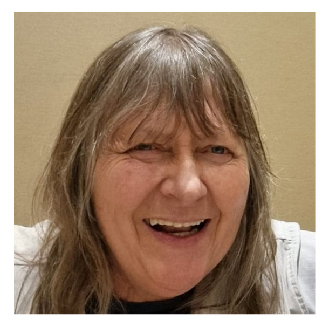 Norma Ratto (UBA, UNLP)
Norma Ratto (UBA, UNLP)
Ratto holds a PhD in Archaeology from the University of Buenos Aires. She is currently a researcher at the Institute of Cultures (UBA-CONICET) and a professor in the Anthropology program at the Faculty of Philosophy and Letters (UBA) and the Faculty of Natural Sciences and Museum (UNLP). She has taught postgraduate courses in master's and doctoral programs at universities in Argentina, Chile, and Uruguay, focusing on archaeological data construction, archaeometric studies, and heritage management. Her research area is western Catamarca Province (Argentina), where she has delved into socio-environmental history from early settlement to the Spanish conquest. Since 1992, she has directed the interdisciplinary Chaschuil-Abaucán Archaeological Project (www.proyectopacha.com), combining humanities and natural science methods. Her scientific output includes studies on ceramic technology, visual languages, consumption practices, archaeometallurgy, bioarchaeology, and isotopic analysis.
Axel E. Nielsen: Plazas, Chullpas, and Painted Caves: Inca Intervention in South Andean Ritual Installations
Pre-Hispanic Andean people understood that ancestors and deities, or wak’as, were full members of their communities. This presentation addresses strategies developed by the Incas to subordinate these powerful beings by analyzing their interventions in plazas, chullpa (burial tower) installations, and rock art sites in different regions of the South Andes.
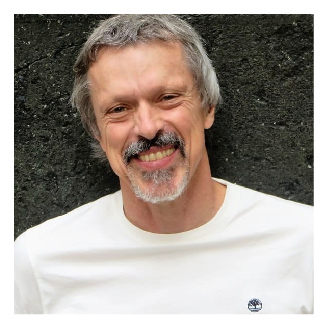 Axel E. Nielsen (CONICET, UBA, UNLP)
Axel E. Nielsen (CONICET, UBA, UNLP)
Nielsen holds a PhD in History from the National University of Córdoba and a PhD in Anthropology from the University of Arizona. He is currently a Senior Researcher at the National Scientific and Technical Research Council (CONICET), Full Professor of "Argentine Archaeology" at the Faculty of Natural Sciences and Museum (National University of La Plata), and Director of the Institute of Archaeology at the Faculty of Philosophy and Letters (University of Buenos Aires). His research focuses on sociopolitical processes during the last millennium of the pre-Hispanic era in the Andes of northwest Argentina, southern Bolivia, and northern Chile, topics on which he has published extensively both nationally and internationally.
Marco Antonio Giovannetti: Special Forms of Inca Architecture: Walls, Rocks, and Distinctive Directions as Manifestations of Worldview
Special forms of Inca architecture, particularly those with zigzagging patterns that stand out in walls and pathways, appear in specific yet striking cases. As seen in Saqsaywaman and other important sites, these features also appear at El Shincal, especially on a ceremonial hill and at the entrances to the plaza. This is linked to particular movements of Inca ritual apparatus.
 Marco Giovanetti (CONICET, UNLP)
Marco Giovanetti (CONICET, UNLP)
Giovanetti holds a PhD in Natural Sciences from the National University of La Plata. He is currently an Independent Researcher at the National Scientific and Technical Research Council (CONICET), based in the Archaeology Division of the La Plata Museum, and an Adjunct Professor of "Argentine Archaeology" at the Faculty of Natural Sciences and Museum (National University of La Plata). His research focuses on the central region of Catamarca Province (Hualfín and Quimivil valleys) at the archaeological sites of Quillay, Los Colorados, and El Shincal. His current studies explore the dynamic role of rituality in state politics and the multiplicity of animated entities (from the perspective of native ontology) that participated in social affairs.
Pablo Cruz: The Metallic Brilliance of the Empire of the Sun: Technological, Political, and Religious Aspects of Metal Production Among the Incas
During their expansion into northwest Argentina, the Incas recognized and took advantage of sophisticated local traditions of bronze production. This is reflected in the regional dissemination of weapons and metal plaques, which served as supports for visual narratives with strong symbolic and religious connotations.
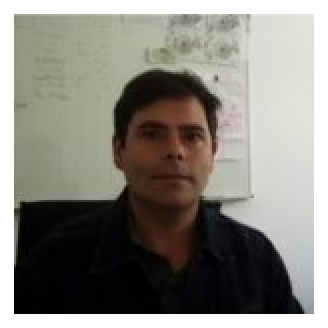 Pablo Cruz (CONICET, UNJu)
Pablo Cruz (CONICET, UNJu)
Cruz is an archaeologist and anthropologist, holding degrees from the University of Artois and the École des Hautes Études en Sciences Sociales (EHESS), as well as a master’s and doctorate from the University of Paris I Panthéon-Sorbonne. He is currently a researcher at the National Scientific and Technical Research Council (CONICET), based at the Regional Social Sciences and Humanities Research Unit (CONICET – National University of Jujuy). His archaeological work focuses on three main areas: ancient Andean mining and metallurgy, human-environment interactions in the southern Andean region, and the dynamics of space sacralization and religious cartographies in this area. His research spans various regions of the Andes in Bolivia and northwest Argentina and has resulted in numerous national and international scientific publications.
Constanza Taboada: Inca Objects and Cotton Clothing in the Santiago del Estero Plain: Gifts, Tributes, and Alliances with Tahuantinsuyu?
This presentation analyzes the relationship between the Inca Empire and indigenous populations of the Santiago del Estero plain (Argentina), an area traditionally considered outside the territory conquered by the Tawantinsuyu. The focus is placed on the role played by Inca metal objects and local textile traditions.
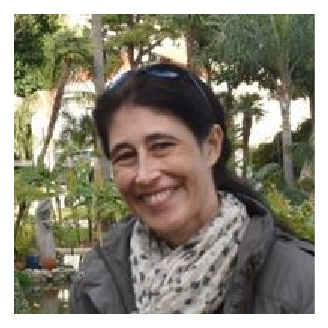 Constanza Taboada (CONICET, UNT)
Constanza Taboada (CONICET, UNT)
Taboada holds a PhD in Archaeology and a degree in Archaeology from the National University of Tucumán. She is an Independent Researcher at the National Scientific and Technical Research Council (ISES-CONICET), a researcher at the Institute of Archaeology and Museum (National University of Tucumán), and an Adjunct Professor in charge of the Field Practice I and Documentation Techniques courses (Faculty of Natural Sciences and IML, UNT). Since 2011, she has led research on the archaeology and history of the Santiago del Estero plain, addressing topics such as pre-Hispanic architecture, landscape use, local Indigenous practices, Inka interactions, Spanish-Indigenous encounters, and the history of archaeology in Santiago del Estero.
Verónica Williams: Objects in Motion: Allies of the State Political Project in Northwest Argentina? Materiality, Practice, and Power of Tahuantinsuyu
In this presentation, we showcase examples of the role played by objects (pottery, metals, architecture, and roads, among others) in the political colonization project of Tawantinsuyu, particularly in the high ravines of the middle Calchaquí Valley in Salta, northwest Argentina. Starting from the concept that objects shape practices, subjectivities, and meanings due to their animated nature, the presentation also highlights how objects define and give meaning to unique and particular spaces—spaces that can be conceptualized as places of high symbolic capital and, therefore, sacred places.
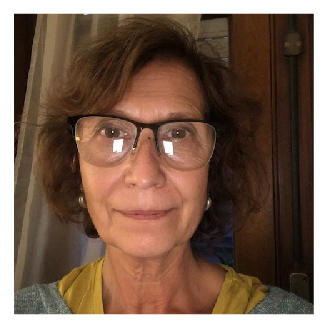 Verónica Williams (CONICET, UBA)
Verónica Williams (CONICET, UBA)
Williams holds a PhD in Natural Sciences with a focus on Anthropology from the National University of La Plata. She is currently a researcher at CONICET, a professor at the University of Buenos Aires, and Director of the Institute of Cultures (IDECU), a joint UBA-CONICET unit since 2016. She has participated in various academic and scientific evaluation committees nationally and internationally and has frequently served as a jury member at national universities. Her research focuses on the pre-Hispanic landscapes of pre-Inka and Inka societies in certain areas of northwest Argentina and northern Chile, as well as pre-Hispanic architecture and technological studies of ceramics and metallurgy. Since 2000, she has directed the Middle Calchaquí Archaeological Project (PACaM), funded by various national and international agencies, and has published over 100 articles and book chapters and edited three books.